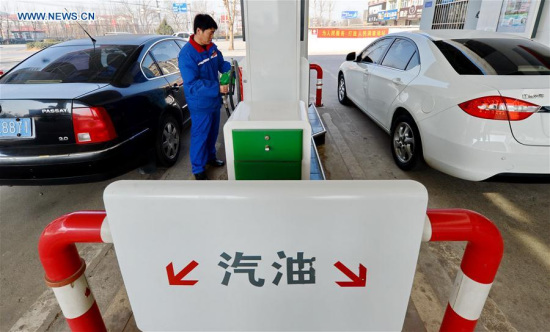
A worker fills a car at a gas station in Cheng'an County, north China's Hebei Province, Jan. 12, 2016. (Photo: Xinhua/Mou Yu)
The prices of crude oil are most likely to stay at relatively low levels in the near future as there are no signs of major producers taking actions to ease a severe oil glut yet.
Nevertheless, some energy officials and analysts said that they expect the oil glut to gradually rebalance itself into 2016, though the high oil prices seen in the past may not be recovered soon.
Observers said that the low oil prices have increased fiscal pressure on oil producers while benefiting oil importers, and that they may be a boon for the still fragile global economy.
On Tuesday, the West Texas Intermediate for February delivery moved down 97 cents to settle at 30.44 U.S. dollars a barrel on the New York Mercantile Exchange, while Brent crude for February delivery shed 69 cents to close at 30.86 dollars on the London ICE Futures Exchange.
International oil prices have been trending downward since 2014 as some of the oil producers increased their output and members of the Organization of the Petroleum Exporting Countries (OPEC) flooded the global market with cheap crude in hopes of driving out competing supplies.
Speaking at the Seventh Gulf Intelligence UAE Energy Forum meeting in Abu Dhabi on Tuesday, United Arab Emirates Energy Minister Suhail bin Mohamed al-Mazroui insisted that it is unfair to ask only OPEC to cut its production given that an estimated increase of 2.7 million barrels of per day in global supply have come from countries outside the oil cartel.
He said that the market should be allowed to rebalance itself based on supply and demand, which should also be OPEC's strategy.
The global oil supply inched up to 96.9 million barrels per day in November last year, which was 1.8 million barrels per day higher than the supply a year earlier, according to the International Energey Agency (IEA).
Separately, the United States Energy Information Agency in its latest report puts the global oil supply in 2015 at 95.71 million barrels per day on average, compared with the consumption of 93.77 million barrels per day. It expects the oil glut to persist through 2016.
OPEC has had an output target, which was last set at 30 million barrels per day. However, in reality the OPEC production has been running at an average of 31.7 million barrels per day, with Saudi Arabia and Iraq pumping at or near record rates, the IEA said.
The pressure on world oil prices also comes from the expectation that the supply from Iran may hit the market this year and concerns that stock building may slow as countries near their storage capacity limits.
The strong U.S. dollar is seen to drive the global oil prices lower, too, as it makes oil more expensive for buyers.
Adam Longson, head of energy commodity research at Morgan Stanley, said that he sees it possible for the oil prices to dip to as low as 20 dollars.
"You can explain most of it by the U.S. dollar," he said, referring to the fluctuations in global oil prices.
OPEC seems still determined to maximize its low-cost supply so as to drive out high-cost non-OPEC production, regardless of price.
There are signs that the strategy is starting to work. The year-on-year growth in non-OPEC supply has fallen to 0.3 million barrels per day in November from 2.2 million barrels per day at the start of 2015.
The momentum in shale energy investment in the United States, which has been seen as a game changer, has shown signs of weakening, too.
In its latest report, the U.S. Energy Information Agency said that U.S. crude oil production averaged an estimated 9.4 million barrels per day in 2015, and it is forecast to average 8.7 million and 8.5 million barrels per day in 2016 and 2017, respectively.
"The crude oil over-supply is still expected to rebalance into 2016," Barnabas Gan, an economist at the OCBC Bank, said a report, projecting international oil prices of 50 dollars per barrel at the end of 2016.
In that case, the oil prices are not likely to recover their past highs in the foreseeable future, given that the shale firms may start adding new wells once the oil prices get above their break-even prices of around 60 dollars. It takes as few as one week to drill a new shale oil well.
The low oil prices have increased fiscal pressure on the oil-dependent countries, including OPEC members. Russia, too, suffers a contraction in its economy, largely due to low oil prices.
The OCBC Bank said the low oil prices have benefited the energy importers that account for a much larger share of world economy.
"Despite the absence of higher global growth in the last year, there are still arguably unambiguous winners from the free-fall behavior in oil prices," Gan said in a report, naming India, South Korea, Japan and China in Asia, and Italy, Spain and Greece in Europe.


















































